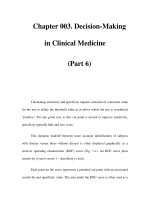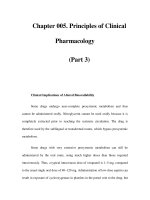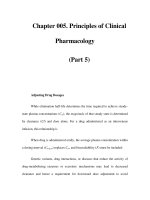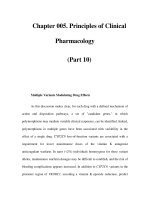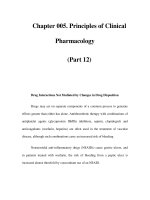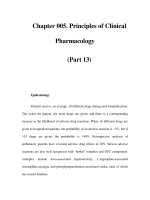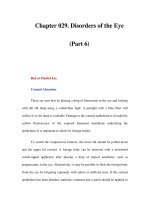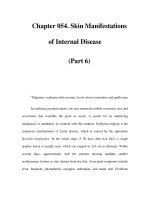Atlas of Clinical Hematology - part 6 doc
Bạn đang xem bản rút gọn của tài liệu. Xem và tải ngay bản đầy đủ của tài liệu tại đây (4.14 MB, 44 trang )
IV
Fig. 84 e – g
e Same case as d shows macrophage
with phagocytized cellular material,
including Auer rods
f Blood smear in complete remission
following ATRA therapy. The neutrophilic
granulocytes appear essentially normal
g Hypersegmented neutrophil in the
same patient
212 Chapter IV · Blood and Bone Marrow
IV
Fig. 85 a, b. Electron microscopic view of atypical
promyelocytes in the M3 and M3 V subtypes of
promyelocytic leukemia (Courtesy Prof. Dr. H. K.
Mu¨ ller-Hermelink, Wu¨ rzburg)
a Atypical promyelocyte in M3. Note the large,
irregular primary granules
b M3 V subtype. At center is a typical bilobed nucleus
with a thin chromatin strand linking the two nuclear
segments. At right is a large nucleolus. The cytoplasm
contains small, sparse granules
213
5 · Bone Marrow
IV
Fig. 85 a
Fig. 85 b
214 Chapter IV · Blood and Bone Marrow
IV
Fig. 86. Schematic diagram and partial karyotype of
the translocation t(15;17)(q22;q12), which is found
in both the M3 and M3 V subtypes of promyelocytic
leukemia. In the rare cases where cytogenetic
analysis is unrewarding – the so-called kryptic PML-
RARA rearrangement – diagnosis can be ensured by
means of FISH or PCR. The interphase FISH-figure
demonstrates a normal cell with two red and two
green signals as well as a cell with the t(15;17)/PML-
RARA-rearrangement in which a red and a green
signal for the uninvolved chromosomes and a red-
green colocalization signal are seen.
In addition to the t(15;17) there exist the extremely
rare variants with the karyotypes t(11;17)(q13;q21)
and the fusion transcript NuMA-RARA, the
t(11;17)(q23;q21), PLZF-RARA, and the
t(5;17)(q32;q12), NPM-RARA. Morphologically these
variants do not exactly correspond in most cases to
the classical subtypes M3 or M3V
215
5 · Bone Marrow
IV
Fig. 87 a – g. Acute myelomonocytic
leukemia, M4 subtype
a Bone marrow smear with undifferen-
tiated blasts and precursors of the
granulocytic and monocytic lines
b Peroxidase reaction in the same
patient shows peroxidase-positive blasts
and later granulocytic precursors.
Monocytic line is negative
c Nonspecific esterase in the same
patient shows strong, diffuse activity
(brown) in four monocytes
d Different patient. Blasts with grayish-
blue cytoplasm (monocytic line). Several
blasts contain coarse granules (granulo-
cytic line)
216 Chapter IV · Blood and Bone Marrow
IV
Fig. 87 e – g
e CE reaction in the same case (d) shows
strong activity in some cells (granulocytic
line) and no activity in others
f Nonspecific esterase reaction in the
same case shows strong, diffuse activity
(grade 4) in most of the cells
g Blood smear in M4 subtype demon-
strates a large proportion of promono-
cytes and monocytes. There was just over
20 % granulocytopoiesis in the bone
marrow, confirming the diagnosis of the
M4 subtype
217
5 · Bone Marrow
IV
Fig. 88 a – g. Acute myelomonocytic
leukemia, M4 subtype
a Pappenheim stain in bone marrow
smear. Blasts and early precursors of
granulocytopoiesis and monocytopoiesis
are difficult to distinguish morphologi-
cally
b Bone marrow from the same patient.
Peroxidase reaction. Almost 100 % of the
cells are peroxidase-positive
c Nonspecific esterase reaction in the
same patient. Approximately 85 % of the
cells are strongly and diffusely positive,
confirming the diagnosis of M4. A large
percentage of the leukemic cells have
both monocytic and granulocytic prop-
erties
d Bone marrow from a different case of
M4
218 Chapter IV · Blood and Bone Marrow
IV
Fig. 88 e – g
e Blood smear from the patient in d.At
center is a segmented neutrophil with
Auer rods. Below it are two monocytes
with atypical nuclei
f Bone marrow histology in M4. Mega-
karyocytes are increased, and some are
dysplastic. HE stain
g Blood smear from the same patient
shows greatly increased platelets and
two monocytes
219
5 · Bone Marrow
IV
Fig. 89 a – d. Variants of the M4 sub-
type
a Severely dysplastic erythropoiesis. At
center are three erythroblasts, two of
which are very immature forms. The cy-
toplasm of the upper erythroblast is va-
cuolated
b PAS reaction in bone marrow from the
same patient shows a strong, coarsely
granular reaction in four atypical
proerythroblasts and a diffuse reaction in
an erythroblast at left. Three precursors of
the white cell line show weak diffuse
staining. There was less than 50 %
erythropoiesis, excluding a diagnosis of
erythroleukemia (M6 subtype)
c Bone marrow in M4 shows increased
numbers of basophilic granulocytes.
Three basophils surround the center of
the field
d Increased basophilic granulocytes in
the bone marrow from a different patient
with M4. At top and right are two baso-
phils with unusually fine granules. To-
luidine blue stain confirms the meta-
chromic reaction of the granules
220 Chapter IV · Blood and Bone Marrow
IV
Fig. 90 a – h. AML with abnormal eosi-
nophils. M4Eo subtype
a This bone marrow smear contains
precursors of granulocytopoiesis, mono-
cytopoiesis, and blasts along with a high
percentage of eosinophils, some of which
(left and right of center) contain abnormal
dark purple-violet granules. There are
also mature eosinophils, some with very
small granules
b Different case shows a striking abun-
dance of abnormal eosinophils. These
cells are easily mistaken for basophils
with Pappenheim stain, but they do not
show a metachromatic reaction with
toluidine blue stain
c Different case with many abnormal
eosinophils. Note the pleomorphism of
the abnormal granules
d Different case with two dysplastic
eosinophils at the center of the field
221
5 · Bone Marrow
IV
Fig. 90 e – h
e Severely dysplastic granules at center.
The presence of this cell is sufficient to
make a diagnosis
f Severely abnormal, immature eosino-
phil and an eosinophil containing very
fine granules
g Abnormal eosinophil (bottom) next to
a group of monocytes
h Blood smear in M4Eo. At top are three
very small monocytes and one monocyte
with an abnormal nuclear structure.
Below it is a pseudo-Pelger neutrophil
form. Abnormal eosinophils are rarely
found in blood films, and bone marrow
examination is necessary to confirm the
diagnosis
222 Chapter IV · Blood and Bone Marrow
IV
Fig. 91 a – f. Cytochemical findings in
M4Eo
a The principal finding is the detection of
CE in the granules of at least some of the
abnormal eosinophils. This differentiates
the abnormal eosinophils of M4Eo from
reactive states and from eosinophils in
other leukemias (e.g., M2 subtype of
AML) in which eosinophils are increased.
An exception is “pure” acute eosinophilic
leukemia (see p. 253). This panel shows
that a varying percentage of abnormal
eosinophilic granules are CE-positive. At
upper left is an eosinophilic myelocyte
with large, 100 % positive granules
b From top to bottom center are three
abnormal eosinophils that are CE-positive
c Nonspecific esterase reaction in the
bone marrow in M4Eo. The monocytes
show the usual strong diffuse reaction. It
is not uncommon, however, to find cases
of M4Eo in which esterase activity is low
compared with M4 and M5, without
abnormal eosinophilia
d PAS reaction. The abnormal granules
may be PAS-positive. This finding is
characteristic but not specific
223
5 · Bone Marrow
IV
Fig. 91 e – f
e, f Adam’s reaction for the detection of
tryptophan. In the blood and bone
marrow, this reaction is positive only in
eosinophilic granules and so is the best
technique for identifying eosinophils.
Note that the abnormal granules and
some Charcot-Leyden crystals, which
form from eosinophilic granules (91f), are
positive
224 Chapter IV · Blood and Bone Marrow
IV
Fig. 92 a – g. Other findings in M4Eo
a, b In bone marrow with a high
percentage of eosinophils, it is not unu-
sual to find macrophages containing
Charcot-Leyden crystals that have
developed from eosinophilic granules.
a Bone marrow smear in M4Eo. Two
macrophages are laden with Charcot-
Leyden crystals, which appear bright blue
in this sample
b Several pale Charcot-Leyden crystals in
a slightly crushed macrophage, which
also contains bluish material (phagocy-
tized granules?)
c Histologic section in M4Eo. Giemsa
stain. The immature (bluish-violet) and
mature (reddish) granules in the eosino-
phils are easily identified
d Blood smear. Even in M4Eo, Auer rods
are sometimes found in bone marrow
cells and rarely in the peripheral blood
225
5 · Bone Marrow
IV
Fig. 92 e – g
e Meningeal involvement may occur in
M4Eo. In this case eosinophils were found
in the CSF during a recurrence
f Electron micrograph of an abnormal
eosinophil. Predominantly eosinophilic
progranules are visible in the cytoplasm.
At upper left is a condensed vacuole,
which develops into eosinophilic pro-
granules. The crystalloid inclusions that
are a typical feature of mature eosino-
philic granules are poorly visualized. The
small dark granules in the intergranular
cytoplasm and in the pale rim of the
condensed vacuole at upper left consist of
glycogen
g Normal eosinophil for comparison. The
granules contain typical crystalloid
inclusions
!
226 Chapter IV · Blood and Bone Marrow
IV
Fig. 93 a, b
a Schematic diagram and partial karyo-
type of the inversion inv(16)(p13;q22),
which is found in acute myeloid leukemia
of the M4Eo subtype. The arrows indicate
the breakpoints
b FISH technique for detecting the
inv(16) in interphase cells. Note the bright
red eosinophilic granules in the cyto-
plasm and, above the nucleus, a signal
(blue-green dot at lower right) from the
normal chromosome 16 and a two-part
signal (two groups of small dots at left)
from the inverted chromosome 16. (From
Haferlach et al. [1996] Blood. 87 : 2459 –
2463)
227
5 · Bone Marrow
IV
Fig. 94 a – h. Monocytic leukemia, M5b
subtype. According to FAB criteria, at
least 80 % of the nonerythroblastic
bone marrow cells must be of mono-
cytic lineage, and fewer than 80 % of
these must be monoblasts
a Blood smear shows five somewhat
atypical monocytes. At top is a neutrophil
with a rod-shaped nucleus
b Blood smear from the same patient.
ANAE shows strong diffuse activity (grade
4) in all monocytic cells
c Blood smear from a different patient
with severe leukocytosis. Besides a
monoblast at top center, the cells consist
of monocytes and promonocytes
d Bone marrow from the patient in c. The
proportion of monoblasts is larger but
still less than 80 %
228 Chapter IV · Blood and Bone Marrow
IV
Fig. 94 e – h
e Blood smear from the same patient.
ANAE demonstrates very strong diffuse
reactivity (grade 4)
f Peroxidase reaction in the same patient
shows a positive segmented neutrophil
with negative monocytes and promo-
nocytes
g Monocytes and promonocytes in the
peripheral blood from a different patient
h Bone marrow smear from the patient
in g shows a higher proportion of pro-
monocytes and monoblasts than in the
blood smear
229
5 · Bone Marrow
IV
Fig. 95 a – d. Monocytic leukemia, M5b
subtype
a Bone marrow smear from a different
patient shows a large proportion of
monoblasts. Borderline form with M5a
b ANAE in the same case shows strong
diffuse activity in four cells
c, d Pronounced erythrophagocytosis in
a case of M5b. The t(8;16) translocation
could not be detected
d
230 Chapter IV · Blood and Bone Marrow
IV
Fig. 96 a – h. Monoblastic leukemia,
M5a subtype. Diagnostic criteria: at
least 80 % of nonerythropoietic bone
marrow cells must be of monocytic
lineage, and at least 80 % of these must
be monoblasts
a Bone marrow smear consists exclu-
sively of monoblasts with round, fre-
quently eccentric nuclei, distinct nucleoli,
and abundant gray-blue cytoplasm
b Peripheral blood from the same
patient also shows 100 % monoblasts,
which appear slightly smaller and
rounder
c Blood smear from the same patient.
ANAE shows strong diffuse esterase
activity in the cytoplasm of the blasts
d Peroxidase reaction in a bone marrow
smear from the same patient. One
residual granulocyte is positive, and all
monoblasts are negative
231
5 · Bone Marrow
IV
Fig. 96 e – h
e Bone marrow smear in a different case
shows very immature-appearing mono-
blasts, which are sometimes interpreted
as nonhematopoietic tumor cells
f Extremely strong ANAE activity in the
bone marrow of the patient in e
g Bone marrow smear from a different
patient with M5a
h Bone marrow smear from the patient
in g. PAS reaction. A segmented neu-
trophil at lower right shows typical strong,
diffuse reactivity. The monoblasts have a
faint diffuse or finely granular reaction,
which is condensed at the periphery of
the cytoplasm to form coarse granules.
This is a typical finding in the monocytic
line
232 Chapter IV · Blood and Bone Marrow
IV
Fig. 97 a – h. Monoblastic leukemia,
M5a subtype
a, b Different regions in the same bone
marrow smear. In panel a, groups of
monoblasts are seen to the left of center
and on the right, along with abundant
normal hematopoiesis. Panel b shows a
different region with 100 % infiltration of
the bone marrow by monoblasts
b
c–e Different regions of a histologic
bone marrow section.
c Largely normal-appearing bone marrow
with abundant megakaryocytes, ery-
thropoiesis, and granulocytopoiesis
d Another site in the same specimen.
A line from top center to lower left
separates the monoblastic infiltrate at
lower right from the area of normal
hematopoiesis at upper left
233
5 · Bone Marrow
IV
Fig. 97 e – h
e Another site showing 100 % mono-
blastic infiltration
f ANAE reaction in a bone marrow smear
from the patient in c–e shows extremely
strong, diffuse reactivity in the mono-
blasts
g Very immature monoblasts in another
patient with M5a
h Peroxidase reaction in a bone marrow
smear from the patient in g. All the
monoblasts are negative; only one
normal residual granulocyte is positive
234 Chapter IV · Blood and Bone Marrow
IV
Fig. 98a. Karyotype of AML, FAB type M5a, with the translocation t(9;11)(p22;q23). Myelo-monocytic and
monocytic or monoblastic leukemias (FAB subtypes M4, M5a, M5b) are mainly associated with translo-
cations involving band q23 of chromosome 11, on which the MLL gene is localized. Besides t(9;11), the most
important of these translocations are t(11;19), t(10;11) and t(6;11). The translocation t(9;11) leads to the
fusion gene AF9/MLL, which, as the others, can be identified by molecular genetic analysis
235
5 · Bone Marrow
IV
Fig. 98b, c. Bone marrow smears of
two patients with the translocation
t(8;16)
b Side by side heavy and only scanty
granulated blasts. Below the middle,
erythrophagocytosis
c High-power view. In the center, one
blast with erythrophagocytosis
236 Chapter IV · Blood and Bone Marrow
